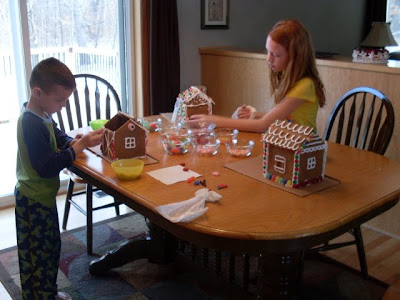
The December 2009 Daring Bakers’ challenge was brought to you by Anna of Very Small Anna and Y of Lemonpi. They chose to challenge Daring Bakers’ everywhere to bake and assemble a gingerbread house from scratch. They chose recipes from Good Housekeeping and from The Great Scandinavian Baking Book as the challenge recipes.



What a fun challenge! I will probably make this a tradition each year; I've bought the kits before but never realized how easy it is to bake it myself. I can hardly wait to try it again and modify the shape of my house! I didn't have a single problem, other than the dough being too dry at the beginning. I only used about 7 and a half cups of flour and it was already dry so I never added the remaining cup and a half. It didn't seem to make a difference- the finished product was perfectly tasty and formed!
I made one batch and it gave us enough to make all three of these houses! I made one and both of my children were able to make one! I didn't help at all with theirs; they both were able to make their own custom homes! Future builders (once the recession recesses?)?
Preparation Time
10 minutes to mix the dough
4-8 hours at least to chill it
5 minutes to roll
10 to rest
10 to cut
Another 30 minutes to rest, if necessary
25-30 minutes to bake, depending on the size of the pieces
I would estimate 2-4 hours to decorate, depending on how ornate you want to make everything. It could certainly take longer if you are doing a lot of intricate royal icing designs or making your own candies. Altogether, this will take 7-13 hours, including chilling time
Ingredients:
2 1/2 cups packed dark brown sugar
1 1/2 cups heavy cream or whipping cream
1 1/4 cups molasses
9 1/2 cups all-purpose flour
2 tablespoons baking soda
1 tablespoon ground ginger
1. In very large bowl, with wire whisk (or with an electric mixer), beat brown sugar, cream, and molasses until sugar lumps dissolve and mixture is smooth.
 *Tip* When pouring molasses or other things of the like, spray a measuring cup with nonstick cooking spray first; the molasses will slide right out!
*Tip* When pouring molasses or other things of the like, spray a measuring cup with nonstick cooking spray first; the molasses will slide right out!In medium bowl, combine flour, baking soda, and ginger. With spoon, stir flour mixture into cream mixture in 3 additions until dough is too stiff to stir, then knead with hands until flour is incorporated and dough is smooth.


 (see my "big cup of tea" in the background? That's the soul of my blog!)
(see my "big cup of tea" in the background? That's the soul of my blog!)2. Divide dough into 4 equal portions; flatten each into a disk to speed chilling. Wrap each disk well with plastic wrap and refrigerate at least 4 hours or overnight, until dough is firm enough to roll.

Be sure to take your jewelry off before handling the dough or else you're left with this:

3. Grease and flour large cookie sheets 17-inch by 14-inch
4. Roll out dough, 1 disk at a time on each cookie sheet to about 3/16-inch thickness. (Placing 3/16-inch dowels or rulers on either side of dough to use as a guide will help roll dough to uniform thickness.)

We dug out the Play-Doh cutters for this project! It seemed as if we had our own zoo made from gingerbread by the time we were done!

Bears included!

5. Trim excess dough from cookie sheet; wrap and reserve in refrigerator. Chill rolled dough on cookie sheet in refrigerator or freezer at least 10 minutes or until firm enough to cut easily.
6. Preheat oven to 300 degrees F
7. Use chilled rolled dough, floured poster board patterns, and sharp paring knife to cut all house pieces on cookie sheet, making sure to leave at least 1 1/4 inches between pieces because dough will expand slightly during baking. Wrap and reserve trimmings in refrigerator. Combine and use trimmings as necessary to complete house and other decorative pieces. Cut and bake large pieces and small pieces separately.


8. Chill for 10 minutes before baking if the dough seems really soft after you cut it. This will discourage too much spreading/warping of the shapes you cut.

9. Bake 25 to 30 minutes, until pieces are firm to the touch. Do not overbake; pieces will be too crisp to trim to proper size.
10. Remove cookie sheet from oven. While house pieces are still warm, place poster-board patterns on top and use them as guides to trim shapes to match if necessary. Cool pieces completely before attempting to assemble the house.

Royal Icing:
1 large egg white
3 cups powdered sugar
1 teaspoon white vinegar
1 teaspoon almond extract
Beat all ingredients until smooth, adding the powdered sugar gradually to get the desired consistency. Pipe on pieces and allow to dry before assembling.

If you aren't using it all at once you can keep it in a small bowl, loosely covered with a damp towel for a few hours until ready to use. You may have to beat it slightly to get it an even consistency if the top sets up a bit. Piped on the house, this will set up hard over time.

We had to find some support items to hold up the rooftop while waiting for the Royal Icing to dry:





































